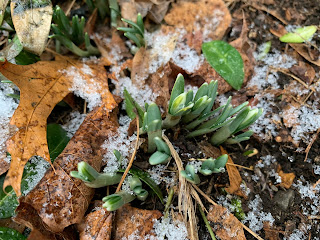 |
| Snowdrops have slowly formed clumps in the front yard |
But the expanding clumps of snowdrops in my garden are most likely clone colonies, groups of connected individuals whose genetic material is identical. Since they’re rarely able to produce seeds, they spread vegetatively as their bulbs reproduce underground and send up new plants.
 |
| Snowdrop bulbs can divide and make offsets-www.BioLib.de |
Snowdrops aren’t the only plants that increase this way, of course. The biggest clone colony in the world is a grove of quaking aspens (Populus tremuloides) in Utah called Pando, reputed to be the world’s largest living thing and one of the oldest.
 |
| Pando in fall-the whole grove is one giant organism |
Pando covers 106 acres, with about 40,000 genetically identical trunks growing from the shared root system, which is about 80,000 years old. When wildfires kill the trees above ground, the roots survive. Another venerable giant clone colony is the King Clone creosote bush (Larrea tridentata) in the Mojave Desert.
In my own yard I’ve got more modest colony formers such as pawpaw (Asimina triloba), sweetshrub (Calycanthus floridus), and highbush blueberry (Vaccinium corymbosum).
 |
| Pawpaw sends out roots to form a clonal clump |
As we recall from high school biology, when two individuals get together to reproduce, their genes are mixed together in the process of meiosis. That gives each of their offspring a unique combination of genes, half from each parent. Colony formers spread asexually by mitosis--plain cell division--passing on the same genes to new individuals, which are clones of their parents. That doesn’t mean their genes never change, because mutations occur spontaneously over time. But the colony has mostly the same genes repeated over and over.
 |
| These snowdrops are genetically identical |
As much as I love seeing the clumps of snowdrops emerge from the leaf litter or the snow, I’d rather that most of my garden plants be more sexually active. When individual plants within a species differ genetically, a diversity of traits will give the species a better chance of coping with predators, disease, and climate change.
 |
| Potatoes blighted in the Irish Famine were clones without diverse defenses-USDA |
This is another reason to buy straight native plants rather than cultivars for my planned pollinator bed. Once a nursery spots a desirable flowering plant as the basis for a cultivar, they reproduce it asexually by cuttings, divisions, or tissue culture. They want new plants that are genetically identical to the desirable ancestor. Straight native species grown from seed, on the other hand, come from open (uncontrolled) pollination by insects, birds or wind. They’ll add biodiversity to the garden.
 |
| Open pollination supports genetic diversity |
Currently cultivars dominate the market. Sometimes even native plant nurseries have to offer plant selections or varieties that are truest to their species, because no straight natives are available. Let’s hope that will change as demand for native species increases.
 |
| I could only find a cultivar of this scarlet beebalm for sale, so I chose another species in the genus |
No comments:
Post a Comment